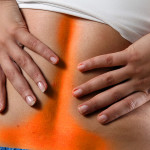Mild Pressure Reduces Nerve Output by 50%!
“Feeling the Pressure?”
 10 mm/Hg (millimeters of mercury) is a measurement of pressure. It isn’t very much pressure at all. If a blood pressure cuff were inflated to that level, you would barely notice it. It certainly wouldn’t interfere with the function of the nerves in your arm. Yet, this same level of pressure can be significant elsewhere in the body.
10 mm/Hg (millimeters of mercury) is a measurement of pressure. It isn’t very much pressure at all. If a blood pressure cuff were inflated to that level, you would barely notice it. It certainly wouldn’t interfere with the function of the nerves in your arm. Yet, this same level of pressure can be significant elsewhere in the body.
More than 25 years ago, a researcher from the University of Colorado presented data on the effects of pressure on nerve fibers.1,2 It turns out that it only takes 10 mm/Hg of pressure to cause significant interference to the function of nerve fibers at the point of exit from the spine, decreasing nerve output by 50%!. This finding reinforces what doctors of chiropractic have noted clinically for decades: Relatively minor misalignments or restrictions in the spine (subluxations), which only generate minor pressures, can cause significant nerve interference.
Ordinary methods of measuring spinal range of motion, analyzing X-rays, and even reading MRIs often fail to detect subluxations. The specialized skills required to locate and correct these subtle disturbances is the central focus of chiropractic education and practice. This specialized training probably accounts for the fact that of all spinal manipulation performed in the United States, 94 percent is in the form of specific adjustments administered by doctors of chiropractic.3
Recent research supports the importance of chiropractic’s unique targeted approach to subluxation. Relief from neck pain and back pain has been shown to be significantly better under chiropractic care than under physical therapy.4,5 An economist at the University of Ottawa has concluded that medication and physical therapy are much less cost-effective than chiropractic care in resolving the pain and loss of overall health in patients with low back complaints.6 These findings argue strongly for inclusion of doctors of chiropractic along with the other valuable members of your health care team.
It is hoped that this information is of use to you in making wise health care decisions and informed referrals.
For more information on low back pain and sciatica, click here.
References
- Sharpless SK: Susceptibility of Spinal Roots to Compression Block, p.155. In Goldstein M, editor: The Research Status of Spinal Manipulative Therapy, Monograph #15, Bethesda, MD, 1975, NIH/NINCDS, U.S. Department of Health, Education & Welfare.
- Ruch WJ: Autonomic Neuroanatomy of the Vertebral Subluxation Complex. In Masarsky CS, Todres-Masarsky M, editors: Somatovisceral Aspects of Chiropractic: An Evidence-Based Approach, Churchill Livingstone, New York, 2001.
- Shekelle PG, Adams AH, et al: The Appropriateness of Spinal Manipulation for Low Back Pain: Project Overview and Literature Review. RAND, Santa Monica, Calif., 1992.
- Koes BW, et al: A randomised clinical trial of manual therapy and physiotherapy for persistent back and neck complaints: subgroup analysis and relationship between outcome measures. J Manipulative Physiol Ther 1993;16(4):211.
- Rosner AL: Musculoskeletal Disorders Research. In Redwood D, Cleveland CS, editors: Fundamentals of Chiropractic, Mosby, St. Louis, Mo., 2003.
- Manga P: Enhanced Chiropractic Coverage Under OHIP as a Means for Reducing Health Care Costs, Attaining Better Health Outcomes and Achieving Equitable Access to Health Services. Report to the Ontario Ministry of Health, Ontario, 1998





